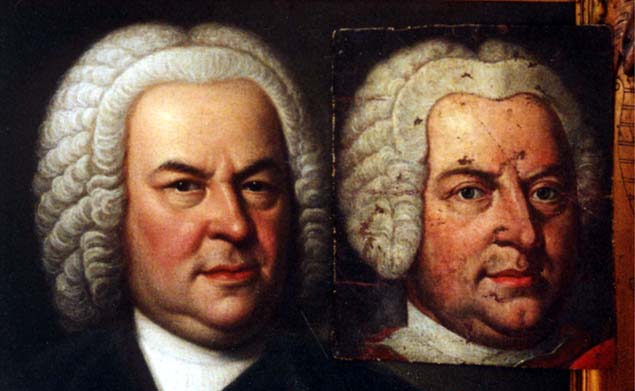The Critical Discographies from Choral Music On Records - Mass in B Minor Pages at the Teri Noel Towe Home Pages
Johann Sebastian Bach
The Critical Discographies from Choral Music On Records
This remarkable photograph is not a computer generated composite; the original of the Weydenhammer Portrait Fragment, all that
remains of the portrait of Johann Sebastian Bach that belonged to his pupil Johann Christian Kittel, is resting gently on the surface
of the original of the 1748 Elias Gottlob Haussmann Portrait of Johann Sebastian Bach.

1748 Elias Gottlob Haussmann Portrait, Courtesy of William H. Scheide, Princeton, New Jersey
Weydenhammer Portrait Fragment, ca. 1733, Artist Unknown, Courtesy of the Weydenhammer Descendants
Photograph by Teri Noel Towe
©Teri Noel Towe, 2001, All Rights Reserved
The Critical Discographies from Choral Music On Records
Mass in B Minor, BWV 232
Mass in B Minor, BWV 232
The Robert Shaw Recordings
With a "correct" complement of five soloists, a superbly prepared small chorus, and a crack "pick-up" orchestra, Robert Shaw
made a recording of the Mass early in 1947 that must have struck those familiar only with the Coates performance as a radical
departure from the norm. [5] In this, one of the last major recordings recorded onto 78 RPM discs (16" acetates), Shaw, like
Coates, indulges in ritards before side breaks from time to time, but his interpretation, unlike Coates's, is remarkably streamlined
and straightforward. The vocal soloists, among the best oratorio singers then active in New York, are all more than adequate, but it
is the instrumental soloists who are particularly impressive. Some of the finest free-lance musicians in the United States participated
in the recording, and the instrumental obbligatos played by the likes of violinist Oscar Shumsky, oboe d'amorist Robert Bloom, and
French hornist John Barrows make for especially rewarding listening.
?
Again with a "correct" complement of five soloists, a superbly prepared small chorus, and a crack "pick-up" orchestra, Shaw
recorded the Mass a second time in June, 1960. [6] His basic interpretation may have changed little in the intervening years, but
nonetheless the recording was both radical and musicologically significant at the time of its release three decades ago. Shaw heeded
the advice of the distinguished musicologist and Bach scholar Gerhard Herz and applied the principle of concertino and ripieno to
many of the choruses. In the especially florid choruses like the "Gloria", the "Cum sancto spiritu", and the "Et resurrexit", for
example, the exposed, sparsely accompanied contrapuntal sections are sung by a group of nine concertisten.
While Herz's analysis of the significance of Bach's "solo" and "tutti" markings in his vocal music now seems to be incorrect in light
of Joshua Rifkin's discoveries, Shaw's application of the "solo/tutti" principle to the choruses in the B Minor Mass in this recording
represented a startling and seminal departure from the standard practice that proved especially refreshing at the time. Its renown in
the '60s and '70s was so widespread that an unauthorized single disc of excerpts was even published by Melodiya in the U. S. S.
R.!
Ironically, however, Shaw's interpretation now sounds dated, because of the surprisingly slow tempos and an approach to the score
that seems rather Romantic even though there are hardly any interpretive excesses in evidence. As in the 1947 set, the singing and
playing are of a very high standard, and it is to be regretted that this important recording of the Mass has been unavailable for so
long; it is a justifiably sought after collector's item.
Not only has an unauthorized disc of excerpts from this performance been published in the U. S. S. R. but also the Soviet state
record label, Melodiya, has issued a recording of a live performance of the Mass that was given by the Robert Shaw Chorale in the
Great Hall of The Moscow Conservatory on November 27, 1962, during the Chorale's historic tour of the Soviet Union. [7] No
soloists are listed on the recording, and at this late date it has proven difficult to determine who the soloists were at this
performance, particularly since most of the solos were rotated among several singers during the course of the tour. As this article
went to press, it was certain only that Florence Kopleff was the full-throated and remarkable contralto and Seth McCoy the
praiseworthy clear voiced tenor in the Moscow performance. Interpretatively, the reading is the twin of the second commercial
account, except that it is yet warmer and more plastic.
Please click here to advance to Page 4 - The Herbert von Karajan Recordings.
Please click here to visit the Endnotes Page.
Please click here to visit the Alphabetical Discography Page.
Please click here to return to the Critical Discographies from Choral Music On Records Main Page.
Please click on  to return to the Johann Sebastian Bach Index Page.
to return to the Johann Sebastian Bach Index Page.
Please click on the  to return to the Teri Noel Towe Welcome Page.
to return to the Teri Noel Towe Welcome Page.
teritowe@alumni.Princeton.EDU
Copyright, Teri Noel Towe, 1989, 1997, 2001
All Rights Reserved
The The Critical Discographies from Choral Music On Records - Mass in B Minor Pages at the Teri Noel Towe Home Pages
are PPP Free web pages.

The The Critical Discographies from Choral Music On Records - Mass in B Minor Pages at the Teri Noel Towe Home Pages
have received the HIP Woolly Mammoth Stamp of Approval from The HIP-ocrisy Home Page.